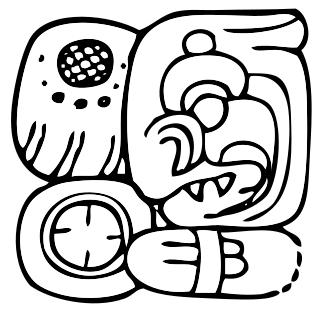
The Mayan numeral system was the system to represent numbers and calendar dates in the Maya civilization. It was a vigesimal (base-20) positional numeral system. The numerals are made up of three symbols; zero, one and five. For example, thirteen is written as three dots in a horizontal row above two horizontal bars; sometimes it is also written as three vertical dots to the left of two vertical bars. With these three symbols each of the twenty vigesimal digits could be written.

The Maya calendar is a system of calendars used in pre-Columbian Mesoamerica and in many modern communities in the Guatemalan highlands, Veracruz, Oaxaca and Chiapas, Mexico.

The Mayan languages form a language family spoken in Mesoamerica and northern Central America. Mayan languages are spoken by at least 6 million Maya peoples, primarily in Guatemala, Mexico, Belize and Honduras. In 1996, Guatemala formally recognized 21 Mayan languages by name, and Mexico recognizes eight more within its territory.
The Haabʼ is part of the Maya calendric system. It was a 365-day calendar used by many of the pre-Columbian cultures of Mesoamerica.
Tzolkʼin is the name bestowed by Mayanists on the 260-day Mesoamerican calendar originated by the Maya civilization of pre-Columbian Mesoamerica.

Classic Maya is the oldest historically attested member of the Mayan language family. It is the main language documented in the pre-Columbian inscriptions of the Classic Era Maya civilization.

Maya script, also known as Maya glyphs, was the writing system of the Maya civilization of Mesoamerica and is the only Mesoamerican writing system that has been substantially deciphered. The earliest inscriptions found which are identifiably Maya date to the 3rd century BCE in San Bartolo, Guatemala. Maya writing was in continuous use throughout Mesoamerica until the Spanish conquest of the Maya in the 16th and 17th centuries.

Ajaw or Ahau ('Lord') is a pre-Columbian Maya political title attested from epigraphic inscriptions. It is also the name of the 20th day of the tzolkʼin, the Maya divinatory calendar, on which a king's kʼatun-ending rituals would fall.

Joljaʼ is an archaeological site of the pre-Columbian Mayan civilization, located in the Chiapas highlands of central southern Mexico. Also known as Cueva de Jolja' in Spanish, the site is a cave which contains a painted mural and a number of inscriptions in the Mayan script which date back to the Early Classic period.
Mesoamerica, along with Mesopotamia and China, is among the three known places in the world where writing has thought to have developed independently. Mesoamerican scripts deciphered to date are a combination of logographic and syllabic values. They are often called hieroglyphs due to the iconic shapes of many of the glyphs, a pattern superficially similar to Egyptian hieroglyphs. Fifteen examples of distinct writing systems have been identified in pre-Columbian Mesoamerica, many from a single inscription. The limits of archaeological dating methods make it difficult to establish which was the earliest and hence the fore-bearer from which the others developed. The best documented and deciphered Mesoamerican writing system, and the most widely known, is the classic Maya script. An extensive Mesoamerican literature has been conserved partly in indigenous scripts and partly in the postconquest transcriptions in the Latin script.
A winpoin, uinal is a unit of time in the Maya Long Count calendar equal to 20 days. It is the 4th digit on the Maya Long Count date.

Like other Mesoamerican people, the traditional Mayas recognize in their staple crop, maize, a vital force with which they strongly identify. This is clearly shown by their mythological traditions. According to the 16th-century Popol Vuh, the Hero Twins have maize plants for alter egos and man himself is created from maize. The discovery and opening of the Maize Mountain - the place where the corn seeds are hidden - is still one of the most popular of Maya tales. In the Classic period, the maize deity shows aspects of a culture hero.

The Mesoamerican Long Count calendar is a non-repeating, vigesimal (base-20) and base-18 calendar used by several pre-Columbian Mesoamerican cultures, most notably the Maya. For this reason, it is often known as the MayaLong Count calendar. Using a modified vigesimal tally, the Long Count calendar identifies a day by counting the number of days passed since a mythical creation date that corresponds to August 11, 3114 BCE in the Proleptic Gregorian calendar. The Long Count calendar was widely used on monuments.

The Dreamspell is an esoteric calendar in part inspired by the Maya calendar by New Age spiritualist, Mayanist philosopher, and author José Argüelles, initiated in 1987 and released as a board game in 1992.

Uxbenka is a pre-Columbian Mesoamerican archaeological site located in Belize's southernmost district of Toledo. An urban settlement of the pre-Columbian Maya, it is the earliest-known Maya polity in the southern Belizean lowlands, with evidence of occupation dating to the Early Classic period of Mesoamerican chronology. It is one of five major Maya sites in this region, whose archaeological sites also include Nim Li Punit and Lubaantun. Settlement of Uxbenka has been suggested to have occurred originally by Peten peoples. The site is approximately 40 square kilometers in size, and Uxbenka is referred to as a medium sized polity ). Uxbenka rose shortly after the expansion of another Mayan site: Tikal. The site is thought to have been first inhabited during the late Preclassic period.

Chactún is the name of an archaeological site of the Mesoamerican Maya civilization in the state of Campeche, Mexico, in the northern part of the Calakmul Biosphere Reserve. The site of approximately 54 acres is located in the lowlands of the Yucatán Peninsula, between the regions of Rio Bec and Chenes. There are some significant differences that have yet to be explained completely, which distinguish it from some of the other nearby sites.

Yoʼnal Ahk III, also known as Ruler 5, was an ajaw of Piedras Negras, an ancient Maya settlement in Guatemala. He ruled during the Late Classic Period, from 758 to 767 AD. Yoʼnal Ahk III ascended to the throne upon the death of Itzam Kʼan Ahk II, who may have been Yoʼnal Ahk's father. He was succeeded by his probable brother, Haʼ Kʼin Xook in around 767 AD. Yoʼnal Ahk III left behind two surviving stelae at Piedras Negras, namely Stelae 14 and 16, the former of which has been called one of the finest niche stelae, according to Simon Martin and Nikolai Grube.

Lady of Tikal, also known as Woman of Tikal, was a queen of the Mayan city of Tikal. She took the throne on April 19, 511 and reigned until about 527.

Haʼ Kʼin Xook, also known as Ruler 6, was an ajaw of Piedras Negras, an ancient Maya settlement in Guatemala. He ruled during the Late Classic Period, from 767–780 AD. Haʼ Kʼin Xook was a son of Itzam Kʼan Ahk II, and he ascended the throne following the death of his brother, Yoʼnal Ahk III. Haʼ Kʼin Xook's reign ended with either his death or his abdication in favor of his brother Kʼinich Yat Ahk II; archaeologists and Mayanists have not arrived at a clear consensus. Haʼ Kʼin Xook left behind several monuments, including stelae at Piedras Negras and a stone fragment from El Porvenir. In addition, a stone seat known as Throne 1 and erected by Kʼinich Yat Ahk II records either the death or abdication of Haʼ Kʼin Xook.

Kʼinich Yat Ahk II, also known as Ruler 7, was the last ajaw of Piedras Negras, an ancient Maya settlement in Guatemala. He ruled during the Late Classic Period, from 781 to roughly 808 AD. Possibly a descendant of Itzam Kʼan Ahk II, Kʼinich Yat Ahk II ascended the throne upon the death of his brother, the sixth ajaw of the site, Haʼ Kʼin Xook. While Kʼinich Yat Ahk II presided over the destruction of the rival Maya site Pomona, his reign likely ended with Kʼinich Tatbu Skull IV of Yaxchilan capturing and subjugating Piedras Negras. Itzam Kʼan Ahk II left behind several monuments, including stelae at Piedras Negras, a stone seat known as Throne 1 which records either the death or abdication of Haʼ Kʼin Xook, and Panel 3 which recounts the exploits of Itzam Kʼan Ahk II.















